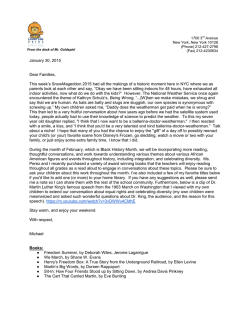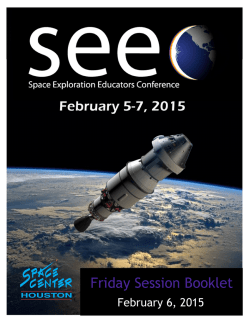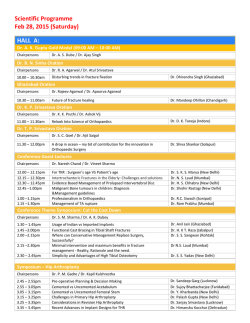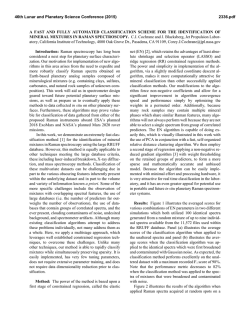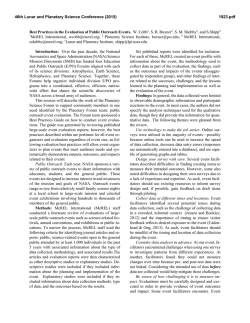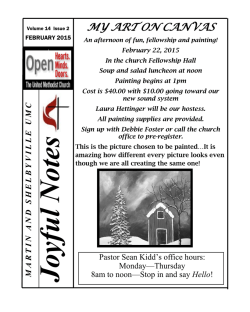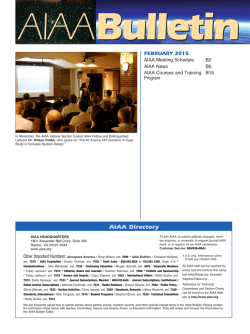
2015 Conference Brochure - AAS Rocky Mountain Section
15-002 PROGRAM Traditional Conference Located at: 38th ANNUAL AAS GUIDANCE & CONTROL CONFERENCE January 30th to February 4th, 2015 FRIDAY, JANUARY 30TH 7:00 AM Check in 8:00 AM Session CLASSIFIED SESSION Classified Advances in G&C and Classified Recent Experiences BEAVER RUN CONFERENCE CENTER Breckenridge, Colorado Room check-in at the Beaver Run Resort front desk 4:00 PM daily. Conference Registration Friday 5:00 to 8:00 PM Daily 6:30 to 10:00 AM and 4:00 to 6:00 PM Daily Poster Session Held in Break Room during Breakfast Pre-registration by Jan 3, 2015 is required and will be controlled (walk-ins will NOT be admitted). Attendees must register for the entire AAS conference to be eligible to attend classified sessions. Contact a local chairperson for more information. The Poster Session offers a unique forum for authors and interested parties to discuss relevant topics. Posters do not require an accompanying written paper. However, authors who wish to have their work published in the proceedings can submit a written paper along with the poster. The Poster Session will be available for viewing every day in the main conference room. Ball Aerospace 10 Longs Peak Drive Broomfield, CO 80021 National Chairpersons Darrell Zimbelman, Dept. of the Air Force Robert McClelland, SSI Local Chairpersons Kyle Miller, Ball Aerospace & Technologies Corp. (303) 533-4348, [email protected] Lisa Hardaway, Ball Aerospace & Technologies Corp. (303) 939-4335, [email protected] 15-004 7:00-10:00 AM (TOP SECRET // SI/TK // NOFORN) Location of Classified Session: 15-003 15-005 15-006 Local Chairpersons Alex May, Lockheed Martin Space Systems Company (303) 977-6620 [email protected] 15-001 Multi-spacecraft Autonomous Positioning System: Conceptual Architecture, Simulation Analysis, Hardware Testing, and Continued Development Evan Anzalone (NASA MSFC) 15-007 Avoiding High-Gain Antenna Occlusions and Flops in Mars Science Laboratory Operations Stephen F. Peters, C. Anthony Vanelli, William C. Allen, Steven M. Collins, James F. Montgomery, Evgeniy Sklyanskiy (NASA JPL) An Error Budget for Pointing at Surface Features from Close Range Stephen F. Peters (NASA JPL) Methodology for the In-Flight Estimation of Collected Regolith Sample Mass on the OSIRIS-REx Mission Michael Skeen, Alexander May, Ryan Olds, Timothy Linn (Lockheed Martin) Two-Axis Fast Mirror Technology Islam Shawki (Raytheon) CubeSat Proximity Operations Demonstration (CPOD) Mission: Concept of Operations for Miniaturized Rendezvous, Proximity Operations, and Docking Jason J. Westphal, Christopher W. T. Roscoe, Marco Villa, Ehson Mosleh, and Dean R. Hawes (Applied Defense) Generalized Covariance Minimization Algorithm for the Continuous Extended Kalman Filter for Nonlinear Plants and Sensor Models Kevin Hernandez, James D. Turner (Texas A&M University) 15-008 15-009 15-010 State Transition Matrix Propagation for Perturbed Orbital Motion Using Modified Chebyshev Picard Iteration Julie Read, John L. Junkins, and Ahmad Bani-Younes (Texas A&M University) Parallel Modified Chebyshev Picard Iteration for Orbit Catalog Propagation and Monte Carlo Analysis Brent Macomber, Austin Probe, Robyn Woollands, and John L. Junkins (Texas A&M University) OSIRIS-REx Asteroid Contact Dynamics From First Principles Will Hafer (Lockheed Martin) SATURDAY, JANUARY 31ST 7AM CONFERENCE OPENING BY IAN GRAVSETH Session I perceived technical readiness level, applicability and fieldability to near-term systems, clarity of written and verbal delivery, number of completed years of schooling and adherence to delivery schedule. The session will be limited to 8 papers with the top 3 papers receiving awards. National Chairpersons Tim Crain, Intuitive Machines (281) 520-3726 [email protected] David Geller, Utah State University [email protected] (435) 797-2952 Student Innovations in GN&C 15-015 Local Chairpersons David Chart, Lockheed Martin Space Systems Company (303) 977-6875 [email protected] Jeff Bladt, Ball Aerospace & Technologies Corp. (303) 939-5971 [email protected] 15-016 15-011 15-017 7:15-10:15 AM This session embraces the wealth of research and innovative projects related to spacecraft GN&C being accomplished in the university setting. Papers in this session address hardware/software research as well as component, system or simulation advances. Papers submitted must have a student as the primary author and presenter. Papers will be adjudicated based on level of innovation, complexity of problem solved, 15-014 15-012 15-013 Attitude Control System Design for Multi-Mode Proximity Operations and Imaging with a 6U Cubesat Francisco J. Franquiz, Bogdan Udrea, Luis A. Sanchez, Shane T. Stebler (Embry-Riddle) Aerodynamic Passive Attitude Control: A New Approach to Attitude Propagation and a Nano-satellite Application J. Micah Fry (Utah State University) Performance Assessment of Horizon-Based Optical Navigation Techniques 15-018 Andrew Liounis, Alexander Entrekin, Josh Gerhard, John Christian (West Virginia University) Small Body Gravity Field Estimation Using Liaison Supplemented Optical Navigation Siamak Hesar, Jeffrey S. Parker, Jay McMahon, George H. Born (University of Colorado) Hardware-in-the-Loop Validation of Sensing and Algorithms for Autonomous Decent and Landing Austin Probe, Dylan Conway, Brent Macomber. Clark Moody, John L. Junkins (Texas A&M University) Active Control Detection Clark K. Moody, Dylan Conway, Austin Probe, John E. Hurtado (Texas A&M University) Experimental Validation of an Inertia-Free Controller and a Multiplicative EKF for Pose Tracking and Estimation Based on Dual Quaternions Alfredo Valverde, Nuno Filipe, Michail Kontitsis, Panagiotis Tsiotras (Georgia Tech) Analysis of Astrodynamic State Variable Formulations Christopher Shelton (Utah State University) In 2015, we will be hosting an inaugural STEM event for one hundred high school students of diverse background from across the Denver metropolitan area. The event, called AAS STEM-SCAPE for “Student Career Arcs to Professional Engineers,” will trace the elements of a successful career journey in aerospace including High School and University education, initial employment and ultimately a rewarding profession. Our keynote speaker is Dr. Neil Dennehy, NASA Fellow, who will be followed by a STEM career panel. The event concludes with a short design project that will be co-led with student volunteers from the University of Colorado. If you are interested in volunteering at the event, please contact our Education Committee planning POCs: design and analysis tools, and services applicable to advancement of guidance, navigation, and control technology. The latest commercial tools for GN&C simulations, analysis, and graphical displays are demonstrated in a hands-on, interactive environment, including lessons learned and undocumented features. Associated papers not presented in other sessions are also provided and can be discussed with the author. Come enjoy an excellent complimentary buffet and interact with the technical representatives and authors. This session takes place in a social setting and family members are welcome! Local Chairpersons Meredith Stephens, Ball Aerospace & Technologies Corp. (303) 939-6759 [email protected] Lis Garratt, Ball Aerospace & Technologies Corp. (303) 335-4416 [email protected] Michael Drews([email protected]) Kristen Francis ([email protected]). SUNDAY, FEBRUARY 1ST 10:30 AM-4:00 PM Inaugural AAS STEM-SCAPE Event Special Event for Children of Conference Attendees at 4 PM NASA Astronaut, Joe Tanner This presentation will inspire our next generation of engineers by offering kids the opportunity to interact with an astronaut who flew four STS missions! Session II 5:00-8:00 PM Technical Exhibits The Technical Exhibits Session is a unique opportunity to observe displays and demonstrations of state-of-the-art hardware, Session III 7:00-10:00 AM Roadmaps and Future Mission Concepts As part of their individual strategic planning efforts NASA, DoD, ESA and other worldwide civilian and national defense space agencies have created, or are in the process of creating roadmaps, for both their advanced GN&C technologies and for their future payload (e.g. sensors and instruments), missions and systems. These international civilian and military space agencies are devoting energy to systematically and strategically plan their GN&C technology investments. In parallel related activities these agencies are also performing studies and analyses to assess their future system objectives, from both the perspectives of technological readiness and programmatic feasibility, as part of the process of formulating ambitious future mission concepts. While many of these future mission concepts are notional it is clear that several will require significant innovation and the first-time infusion of emerging technologies to satisfy challenging GN&C system engineering requirements. In this session the authors will present papers on GN&C technology roadmaps, future mission concepts and their interrelationship. National Chairpersons Cornelius J. Dennehy, NASA Engineering & Safety Center (NESC) (240) 687-9077 [email protected] Davin K. Swanson, The Aerospace Corp. [email protected] (310) 336-8795 Richard Scott Erwin, Air Force Research Laboratory, Space Vehicles Directorate [email protected] (505) 846-9816 Local Chairperson Scott Mitchell, Ball Aerospace & Technologies Corp. 303-939-4386 [email protected] 15-041 15-042 APNM spacecraft: An EP-based versatile mission concept with a single integrated GNC solution for active multi-debris removal and satellite commercial servicing Guillame Pionnier & P-N. Gineste (AIRBUS Defence and Space) Looking Back and Looking Forward: Reprising the Promise and Predicting the Future of Formation Flying and 15-043 15-044 15-045 15-046 15-047 Spaceborne GPS Navigation Systems Frank Bauer & Neil Dennehy (Emergent/NASA Engineering & Safety Center) Industry Perspective on Space Universal Modular Architecture (SUMO) concepts applied to Momentum Control Components Tim Hindle and Tim Hintz (Honeywell) Future Micro-PNT Technology Applications in GPS/IMU Integration Walter E. Lillo, Scot L. Osburn, and Manorama Gollakota (Aerospace Corp.) A Miniature, Low-Power Star Tracker for Precision Pointing Nanosatellites Darren W. Rowen , Alexander C. Utter , Richard M. Dolphus , Eddson M. Alcid and Evan R. Ulrich (Aerospace Corp.) An Overview of the NASA Space Communications and Navigation (SCAN) Roadmap Jim Schiers (NASA HQ HEOMD SCaN Office) Agilitoid-Based Design Analysis of Next Generation Attitude Control Systems Mark Karpenko, Jeffery T. King, Steven R. Crews, and I. Michael Ross (Naval Postgraduate School) 15-048 A Survey of Guidance, Navigation, and Control Technologies for Future Planetary Science Missions Ed Riedel & Mimi Aung (JPL) Session IV 15-052 2:00-4:00 PM Space Debris Although many methods of monitoring and detecting debris for avoidance purposes are already in place, space debris continues to be a growing issue within the aerospace community. This session will focus on characterization of the current debris environment and will also discuss ongoing or future efforts for debris mitigation that may be underway or are proposed. 15-053 15-054 National Chairpersons Gene Stansbery, NASA 281-483-8417 [email protected] Tim Coffin, Brigadier General, United States Army, Commander, White Sands Missile Range 575-678-1101 [email protected] Local Chairpersons Cheryl Walker, Lockheed Martin Space Systems Company 303-772-2149 [email protected] Steve Jolly, Lockheed Martin Space Systems Company 303-971-6758 [email protected] John Abrams, Analytical Mechanics Associates, Inc 303- 953-1016 x102 [email protected] 15-051 Trajectory Optimization for a Solar Electric Propulsion Orbital Debris Removal Ferry 15-055 M. Duchek (Analytical Mechanics Associates) Falco: An Affordable Orbital Debris Removal Mission Simplified by Use of a Passive Despin Device R. Rohrschneider, R. Arentz, I. Gravseth, B. Landin, L. Guy, R.Schweickart (Ball Aerospace) Performance Optimization Study for Touchless Electrostatic Spacecraft DeSpin Operations D. Stevenson, H. Schaub (University of Colorado) Evolutionary Optimization of a Rendezvous Trajectory for a Satellite Formation with an Orbital Debris Hazard D. Hinckley Jr., D.Hitt (University of Vermont) The ADCS of a Rendezvous and Docking Technology Demonstrator Mission Target Satellite with Unusual Requirements Nicolai , et al (Astrofeine) MONDAY, FEBRUARY 2ND DUAL MORNING SESSIONS Session V 7:00-10:00 AM In Space Propulsion Innovations Technology innovations in the area of space propulsion have become prominent recently with notable DOD, NASA, and industry investment in green propellant thrusters, cryogenic propellant storage, high-power electric propulsion systems, and propellantless propulsion. Additionally, trends toward employing small spacecraft for an increasing range of applications are driving demand for efficient propulsion technologies for high-mobility micro/nano/picosatellites. This session will highlight emerging propulsion hardware and systems and their GN&C implications that address diverse implementations such as fine pointing for science spacecraft, lowthrust cargo transfer, high-thrust Earth and Mars departure, and descent to / ascent from planetary bodies. National Chairpersons Jeffrey Sheehy, NASA [email protected] 256-698-8635 Roger Myers, Aerojet Rocketdyne [email protected] 425-702-6821 Local Chairpersons Bryce Unruh, Ball Aerospace & Technologies Corp. 303-939-6591 [email protected] Christy Edwards-Stewart, Lockheed Martin Space Systems Company 303-977-5302 [email protected] 15-051 15-052 15-053 New Developments in Conventional Propulsion Olwen M. Morgan, Fred C. Wilson (Aerojet Rocketdyne) The Air Force Research Laboratory’s In-Space Propulsion Program Brian E. Beal (AFRL) Green Propellant Infusion Mission Program Development and Technology Maturation 15-054 15-055 15-056 15-057 15-058 Chris McLean, Brian Marotta (Ball Aerospace) Advances in Propellantless InSpace Propulsion Technologies Les Johnson (NASA MSFC) System Implications for GN&C and High Power SEP Spacecraft Steven Overton, Joe Cassady, Kevin Kelleher (Aerojet Rocketdyne) Guidance, Navigation, and Control Considerations for Nuclear Thermal Propulsion Michael Houts (NASA MSFC) On the Implementation of Microelectrospray Propulsion Systems in CubeSat-Class Spacecraft Matt Sorgenfrei,Matt Nehrenz (NASA ARC), Rob Thomas (NASA GRC) Development and Characterization of a Monopropellant Microthruster with CubeSat Attitude Control Applications M. Ryan McDevitt (GreenScale Technologies), Darren L. Hitt (University of Vermont) and implement new and novel architectures and technologies to solve the GN&C problems. This session is open to papers with topics concerning GN&C hardware ranging from theoretical formulations to innovative systems and intelligent sensors that will advance the state of the art, reduce the cost of applications, and speed the convergence to hardware, numerical, or design trade solutions. Note: Advances in GN&C software are covered in Session IX. National Chairpersons Bryan Dorland, USNO [email protected] 202-762-0134 David Richie, USAFA [email protected] 719-333-6734 Local Chairpersons Lee Barker, Lockheed Martin [email protected] 408-742-4679 Scott Francis, Lockheed Martin [email protected] 303-977-8253 Michael Osborne, Lockheed Martin [email protected] 303-977-5867 15-061 15-062 15-063 15-064 Session VI 7:00-10:00 AM Advances in GN&C Hardware Many programs depend on heritage, but the future is advanced by those willing to design GOES-R Dual Isolation Doug Freesland (Various) ASTRO APS Star Tracker Operations on AlphaSat Uwe Schmidt,Boris Pradarutti (Jena-Optronik GmbH) HYDRA JUICE Star Tracker Benoit Gelin (Sodern) ESTADIUS: A Daytime Accurate Attitude Estimation System for Stratospheric Balloons, Based on Gyro-stellar Measurement Johan Montel (CNES, ThalesServices) 15-065 15-066 USAFA’s EyasSat3 and Hamster Ball: Innovative Tools for Practical, Hands-on Attitude Dynamics and Control Education Dave Richie (USAFA) XACT – A New Generation of Nano GN&C Technology Daniel Hegel (Blue Canyon Technologies) 15-067 Ellis King, Charles Stark Draper Labratory [email protected] 303-977-4478 15-081 15-082 Optical Inspection of a NonCooperative Satellite T. Karlsson, E. Gröndahl, R. Larsson, P. Bodin (OHB Sweden) 15-083 Global Precipitation Measurement Mission Launch and Commissioning N. R. Davis, K. D. DeWeese, J. R. O'Donnell, Jr., M. F. Vess, G. L. Welter (NASA/GSFC), Hao Ton (ASRC Federal) CryoSat-2 : In-Orbit Star Tracker Improvements Nic Mardle (ESA) DUAL EVENING SESSIONS Session VII 4:00-6:00 PM Recent Experiences I This session focuses on recent experiences in spaceflight GN&C, providing a forum to share insights gained through successes and failures. Discussions typically include GN&C experiences ranging from Earth orbiters to interplanetary spacecraft. This session is a traditional part of the conference and has shown to be most interesting and informative. National Chairpersons Brett Smith, NASA Jet Propulsion Laboratory, 818-393-0525 [email protected] Nic Mardle, ESA Operations Center, [email protected] +49 170 9166172 Local Chairpersons Suraj Rawal, Lockheed Martin Space SystemsCopmpany, 303-971-9378 [email protected] Thermally Constrained FuelOptimal ISS Maneuvers S. Bhatt (Draper Lab), A. Svecz, (Rice University), A. Alaniz, JiannWoei Jang (Draper Lab), L. Nguyen (NASA/JSC), P. Spanos (Rice University), 15-084 NEOSSat: Microsatellite Based Space Situational Awareness S. Thorsteinson, (Royal Military College of Canada), R. Scott, B. Wallace (Defence R&D Canada) 15-085 Three Mid-Mission Improvements to Mars Science Laboratory Surface Attitude Estimation Accuracy S. F. Peters, S. M. Collins, C. A. Vanelli, M. L. Robinson, J. F. Montgomery, S. C. Johnson (NASA/JPL) Session VIII 4:00-6:00 PM Low-Thrust Mission Planning The Low-Thrust Trajectories Mission Planning session offers an exciting opportunity to examine the state of the art in low-thrust mission design. The session focuses on the applications of low-thrust technology to enable new classes of missions, such as Dawn's mission to Vesta and Ceres, Hayabusa II's mission to asteroid 1999 JU3, the Asteroid Redirect Mission (ARM) concepts, and even GOCE's mission in a very low Earth orbit. Low-thrust missions involve new and different challenges, compared to conventional missions, due to the extended burn durations and the interactions of the spacecraft with the propulsion system. Solar electric propulsion technology is advancing rapidly and the mission design community is working to discover the new opportunities it provides. National Chairpersons Nathan Strange, Jet Propulsion Laboratory [email protected] (818) 393-1165 Michael Elsperman, Boeing [email protected] (714) 896-5256 Local Chairpersons Jeff Parker, University of Colorado Boulder [email protected], 303-492-7061 Shawn McQuerry, Lockheed Martin Space Systems Company 303-729-4425 [email protected] 15-081 Mission Design for a Crewed Earth-Venus-Mars Flyby 15-082 15-083 15-084 15-085 Mission Using Solar Electric Propulsion Stijn De Smet (University of Colorado Boulder) Finite Horizon Continuous Thrust Guidance for Interplanetary Transfers Robyn Woollands (Texas A&M) Low-Energy, Low-Thrust Transfers Between Earth and Distant Retrograde Orbits about the Moon Jon Herman (University of Colorado) Linear Covariance Analysis for Proximity Operations around Asteroid 2008EV5 Cinnamon Wright (NASA / JSC) SEP-Enabled ESPA-Class Satellite for Near-Earth Applications William Deininger (Ball Aerospace) NETWORKING EVENT 6:00-7:30 PM In lieu of the traditional banquet, a generous appetizer buffet will be provided on Monday evening. This will be an opportunity for conference attendees and guests to network with each other, and the event will also include the presentation of the student paper. TUESDAY, FEBRUARY 3RD DUAL MORNING SESSIONS Session IX 7:00-10:00 AM Advances in GN&C Software The GN&C hardware is often dependent on successful and innovative GN&C software. This session is open to all GN&C software ranging from on orbit software used to drive or process data, ground software used for operations or simulation software used to test, validate or develop GN&C systems. This session aims to highlight GN&C software from all aspects. Note: Advances in GN&C hardware applications are covered in Session VI. National Chairpersons Brad Moran, Charles Stark Draper Laboratory [email protected] 617-258-1263 Scott Glubke, NASA Goddard [email protected] 301-286-5914 15-093 15-094 15-095 Local Chairpersons Lee Barker, Lockheed Martin Space Systems Company [email protected] 408-742-4679 Scott Francis, Lockheed Martin Space Systems Company [email protected] 303-977-8253 Michael Osborne, Lockheed Martin Space Systems Company [email protected] 303-977-5867 15-091 15-092 Lattice Boltzmann Method for Spacecraft Propellant Slosh Simulation Jeb Orr (Draper) Joseph Powers (NASA Marshall) Hong Yang (CFD Research Corp) TARANIS: AOCS Overview and Flexible Mode Issues During Orbit Maneuver J. Lefebve, E. Bellouard, L. 15-096 15-097 Boissier, S. Tremolieres, S. Mary, C. Bastien-Thiry (CNES) A Study of Optical Navigation Measurements for Cislunar Navigation Shane Robinson, Christopher D’Souza (NASA Johnson) John Christian (West Virginia University) Piloting and Guidance Algorithms for Autonomous Landing Carlos Norberto Pérez Montenegro, Enrico Canuto (Politecnico di Torino) Attitude Determination and Control Approach to Achieve CoLocated Microwave Radiometer and GPS Radio Occultation Measurements on a Nanosatellite Weston Marlow, Anne Marinan, Kathleen Riesing, Tam Nguyen, Kerri Cahoy, James Byrne, Andrew Kennedy, Ryan Kingsbury, Zachary Decker, Timothy Cordeiro, Stephen Shea (MIT), Rebecca Bishop, James Bardeen, David Ping, Susan Lui, Tamitha Mulligan (Aerospace Corp) Advances in ORION's On-Orbit Guidance and Targeting System Architecture Sara Scarritt, Shane Robinson (NASA Johnson) Airborne Simulation of Launch Vehicle Dynamics Jeb Orr (Draper) Christopher Miller, Curtis Hanson 15-098 (NASA Dryden) Eric Gilligan (NASA Marshall) High Angular Rate Determination Algorithm Based on Star Sensing F. Curti, D. Spiller (DIAEEARCAlab), S. Bucucci, F. Boldrini (Selex ES), G. Sechi (ESA) Session X 15-112 7:00-10:00 AM Proximity Operations Proximity operations imply maneuvering of a vehicle near another body. This session aims to explore the GN&C aspects of spacecraft operations in the vicinity of other spacecraft, including maneuvering, rendezvousing, and docking, and landers maneuvering near planetary surfaces. Papers may include GN&C algorithms, system studies, space and test flight experience, and sensors that provide the necessary data for proximity operations. National Chairpersons Miguel San Martin, Jet Propulsion Laboratory, 818-354-3593 [email protected] Benjamin Reed, NASA Goddard Space Flight Center 301-286-4755r [email protected] Local Chairpersons Tim Bevacqua, Lockheed MartinSpace Systems Company 703-282-4631 [email protected] Reuben Rohrschneider, Ball Aerospace & Technologies Corp. 303-939-7197 [email protected] 15-111 RAVEN: An On-Orbit Relative Navigation Demonstration Using International Space Station 15-113 15-114 15-115 15-116 Visiting Vehicles Matthew Strube, John Van Eepoel (NASA-GSFC), Eugene Skelton (Lockheed Martin), Ross Henry (NASA-GSFC), Christopher D'Souza (NASA-JSC) A 6-DOF Pose Initialization Strategy for LIDAR-Based NonCooperative Navigation John O. Woods, John A. Christian, Thomas Evans (West Virginia University) Guidance, Navigation, and Control Algorithms for Cubesat Formation Flying Christopher W.T. Roscoe, Jason J. Westphal, Stephen Lutz (Applied Defense Solutions, Inc.), Trevor Bennett (University of Colorado) Comparison of Approaches to Relative Navigation Using Global Positioning During Flight of the Cygnus Spacecraft Alex Manka (Orbital Sciences Corp.) A New Peripheral Docking Target for the International Space Station Chris Foster (Jacobs) A Sampling-Based Approach to Spacecraft Autonomous Maneuvering with Safety Specifications Joseph A. Starek (Stanford University), Brent Barbee (NASAGSFC), Marco Pavone (Stanford University) 15-117 15-118 Angles-Only Navigation Range Observability During Orbital Rendezvous and Proximity Operations David K. Geller (Utah State University), T. Alan Lovell (Air Force Research Lab) Nonlinear Representations of Satellite Relative Motion Equations Using Spherical Transformations Alex Perez (Utah State University), T. Alan Lovell (Air Force Research Lab) Session XI 4:00-7:00 PM Small Body Proximity Operations GN&C operations in weak gravitational environments are mission-enabling for innovative science missions to small bodies such as asteroids and comets. GN&C in this environment is challenging due to the unusual navigation data types, nonconservative force modeling for guidance and trajectory prediction and the precision required for hyperbolic flyby, hovering, landing, and sample return operations. This session explores the GN&C challenges, designs, predicted performance and recent experiences for a variety of current and planned missions to small bodies. National Chairpersons Dan Scheeres, University of Colorado [email protected] 303-492-7420 Shyam Bhasharan, JPL [email protected] Local Chairpersons Bill Frazier, JPL 818-354-1369 [email protected] Dan Kubitschek, Lockheed-Martin Space Systems Company (303) 971-8150 [email protected] 15-126 15-121 15-122 15-123 15-124 15-125 Flyby-only science operations for an asteroid exploration mission Dan Scheeres, S. Van wal, , (University of Colorado), S. Tardivel, (NASA / JPL) Rosetta Navigation at Comet Churyamov-Gerasimenko Shyamkumar Bhaskaran, Stephen Broschart, Don Han, Bill Owen, Nick Mastrodemos, Ian Roundhill, Brian Rush, Jonathon Smith (JPL), David Surovik (University of Colorado) Optical Navigation for the Rosetta mission Nickolaos Mastrodemos, William Owen Jr., Brian Rush (JPL) The Application of Optical Based Natural Feature Tracking to OSIRIS-REx Asteroid Sample Collection Ryan Olds , Alex May, Reid Hamilton (Lockheed Martin SSC), Courtney Mario (Draper Laboratories), Chris Debrunner (Lockheed Martin MFC), Updated OSIRIS-Rex Touch-AndGo (TAG) Analysis with Expected Performance Kevin Berry (NASA), Michael C. Moreau, (NASA GSFC) Peter Antreasian (KinetX, Inc.) Alex 15-127 15-128 May, Brian Sutter (Lockheed Martin SSC) conference and has shown to be most interesting and informative. Flash LIDAR Based Ranging and Surface Contact Time Prediction for the OSIRIS-REx Mission Oliver Walthall, Keith Mahoney (Lockheed Martin SSC) The Small-Body Dynamics Toolkit and associated closeproximity navigation analysis tools at JPL Stephen Broschart (JPL), Matthew Abrahamson, Shyam Bhaskaran, Eugene G. Fahnestock, Reza Karimi, Gregory Lantoine, Thomas A. Pavlak, (JPL), Loic Chappaz (Purdue University) National Chairpersons Brett Smith, NASA Jet Propulsion Laboratory, 818-393-0525 [email protected] Nic Mardle, ESA Operations Center, [email protected] + 49 170 9166172 Real-Time Mapping and Localization under Dynamic Lighting for Small-Body Landings Dylan Conway, John Junkins (TAMU) WEDNESDAY, FEBRUARY 4TH Session XII Local Chairpersons Jim Chapel, Lockheed Martin Space Systems, 303-977-9462 [email protected] Kristen Francis, Lockheed Martin Space Systems, 303-971-7450 [email protected] 15-131 Recent Experiences of the Kepler K2 Mission D. Putnam, D. Wiemer, J. Troeltzsch (Ball) 15-132 Initial On-Orbit Performance of the MAVEN Spacecraft P. Good, W. Pisano (Infinity Engineering), D. Howell , M. Johnson (Lockheed Martin SSC), J. Wynn (Advanced Solutions) 15-133 Gaia: First in Flight Operations Experience D. Milligan, A. Rudolph, F. di Marco, J. Marie (ESA) 15-134 Post-flight analysis of the Guidance and Control Performance During Orion Exploration Flight Test 1 7:00-10:00 AM Recent Experiences II This session focuses on recent experiences in spaceflight GN&C, providing a forum to share insights gained through successes and failures. Discussions typically include GN&C experiences ranging from Earth orbiters to interplanetary spacecraft. This session is a traditional part of the A. Barth (Lockheed Martin IS&GS) 15-135 GLN-MAC Initialization Approach & Navigation Solution as Applied to LDSD B. Tibbetts, J. Benton (Orbital Sciences), E. Blood, S. Sell (NASA/JPL) 15-136 MSL Cruise Attitude Control Flight Experience and Implications for Mars 2020 S. Collins, E. Hines, A. San Martin, F. Serricchio (NASA/JPL) 15-137 Messenger's Maneuvers During the Mission's Low Altitude Campaign S. Flanigan, M. Kirk, D. O’Shaughnessy, S. Bushman, P. Rosendall (Johns Hopkins/APL)
© Copyright 2026
